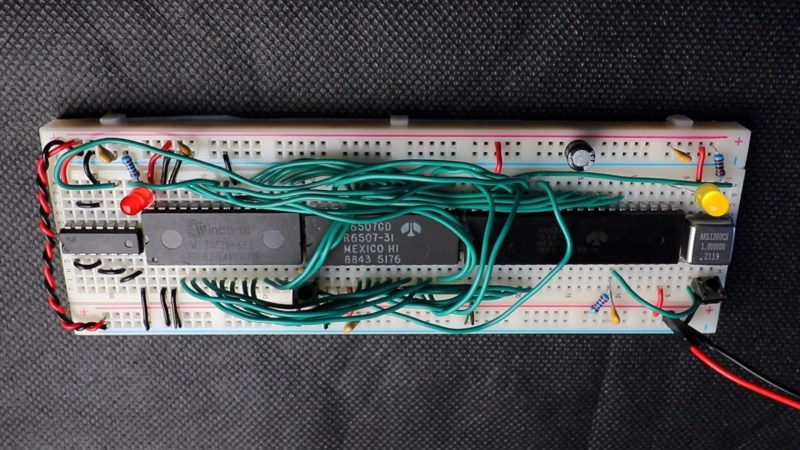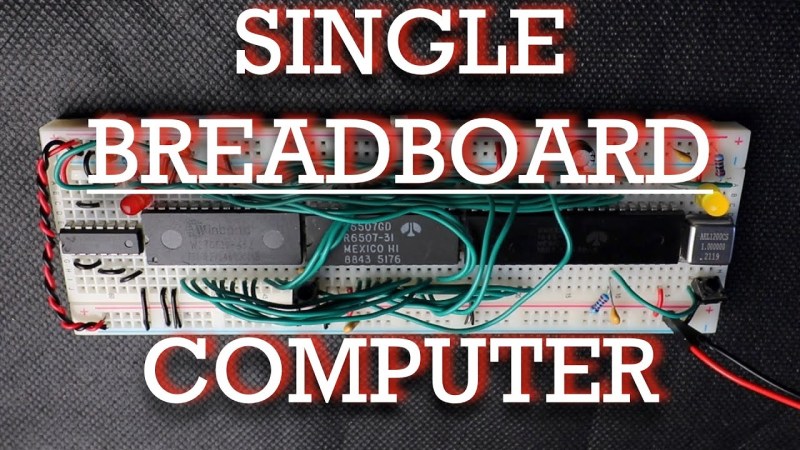Over the years, and especially lately, we’ve seen tons of single-board retrocomputer builds. That’s fine with us — the more, the merrier. But they all start to run together a bit, with little to distinguish between them. Not so this about-as-compact-as-possible 6502 computer that fits on a single breadboard.
Now, when you do the math, it seems like there’s no way that [Anders Nielsen] would have been able to fit even a minimal chipset onto a standard solderless breadboard. The 40-pin 6502 alone takes up nearly two-thirds of the connections available; add in equally large but necessary chips like the 6522 interface adapter, ROM and RAM chips, and some support ICs, and one breadboard isn’t going to cut it. Luckily, some frugal engineers at MOS back in the 70s came up with the 6507, a variant on the 6502 in a 28-pin DIP. The other key to this build is the 6532 RAM-I/O-timer chip or RIOT, which puts a tiny amount of RAM and some IO lines on a single 40-pin DIP. Along with a 28-pin ROM, a 14-pin hex inverter, and a little crystal oscillator, the entire chipset just barely fits on a single breadboard.
But what can this minimalist 6502 actually do? As you can see in the video below, anything a 555 timer can do, and maybe a little bit more. That’s not a dig, of course — [Anders] actually calls out his initial blinkenlight application as a little more than a glorified 555, and actually comes up with a marginally more complex application just to prove the point. The interesting part here is dealing with the constraints imposed by the limited resources available on this machine.
We’re looking forward to whatever comes next for this clever build. It’s hard to see how some of the plans [Anders] has for it will still fit on a single breadboard, though — these things tend to spread out as they go.

















the 6507 was a customized version of the 6502 that was initially mad exclusively for Atari. The original ones didn’t even have 6507 anywhere on the chip. It was designed for the Atari vcs and later used in several of the computer peripherals. It has limited address space compared to a full blown 6502.. The RIOT chips were also used in Atari products that had the 6507.
Look like something Jay miner and friends managed to do way back in 1977 at atari, you’re just missing Tia, otherwise it’s pretty much a vcs with no video or sound
It’s definitely striking just how much this is “so here’s the 2/3 of the 2600 that I can buy for sane amounts of money”
I have what I think I remember is a 6509 Developers Chip. It has a Factory Socket Piggyback on the 65xx Main Chip and has a whopping 256 Words of Ram and the RIOT is internal.. So ONE chip Computer System.. with a few External passives..
I just put my hands on it over the last week. I was curious if I could still find it with all of the 6502 talk as of late..
The Data Plate on it is very hard to read.. SOMEWHERE I should still have all the Documents on it..
It was a Prototype I was developing in about ’83 as a machine Interface.. I did Discrete LED’s as a display, the the Input was a Serial Bit Banged Keyboard, as well as Quad Input Encoder.. I also had to Design the Quad Decoder In Chip, and feed the Count BCD into the I/O to the CPU..
Great Fun.. That was my First ‘Completely Homebrew OS’ for a Computer system..
I have always had a sweet spot in my heart for the 6502
Cap
EDIT:..
The Socket is for a ROM Chip.. So its changeable ROM in a single footprint.
You could also put a 6502 emulator into an Arduino (atmega328p) and have your 1-chip 6502 computer system.
https://forum.arduino.cc/t/arduino-6502-emulator-basic-interpreter/188328
Kinda defeats the point don’t you think?
You could also emulate an intimate relationship through the use of pornography and your own hands, but most people would likely prefer the real deal.
Using the 6532’s IO pins you could implements a bit-banged serial interface for this.
Everyone here should definitely check out “Ben Eater” on YouTube. He has an awesome series on building a while computer on a breadboard. With a graphics card of sort and even USB keyboard. All done in assembly, too.
You could also implement bankable ROM … the unused ROM address pins could be tied to RIOT I/O pins, with pulldown resisters so they are pulled to 0 on powerup.